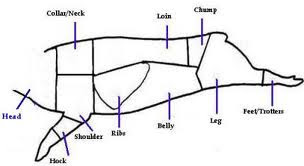
Belly (Tiyan)
Chump
Chump is usually sold in the form of chops and steaks, although you can buy small joints of this cut. Suitable for frying, grilling and roasting, it's medium priced cut of pork.
Collar or Neck End (liog)
Collar can be cut into chops, steaks, diced pork and mince. It's slightly fatty and doesn't dry out easily making it suitable for longer periods of cooking. It is also cured for bacon boiling joints. One of the economical cuts of pork/bacon.
Feet/Trotters (Tiil)
Possibly the cheapest cut, it has fallen out of favour over the past 30 years in any countries although some high class restaurants are bringing it back to their menus. Suitable for slow moist cooking.
Head (Ulo)
In many countries in the west, the head is looked down upon and very rarely used except for the making of brawn types of recipes. However as it's very cheap, it shouldn't be overlooked especially in the making of stocks and soups.
Hock
Hock is almost always sold smoked. A cheap cut of pork, it requires a longer cooking period and is suitable for use in soups, stews and braised dishes where it adds richness and flavour.
Leg / Ham/ Pata (Hamon)
The leg is considered to be the premium pork joint. Roasting joints from the leg are very lean which makes it a more expensive cut of pork. Steaks and diced meat from the leg are also often sold and are suitable for grilling or stir-frying. This part is also cured into ham, gammon roasting joints, gammon steak and the highest quality bacon.
Loin (Lumo)
The loin runs across most of the back of the pig. This is where many bone-in chops come from as well as joints which can be bone in or boned which is sometimes stuffed and rolled. It is also cured into bacon and bacon rashers which ranges from lean to streaky. Most of the cuts are all mid-priced although larger roasting joints from this area are more expensive.
Ribs (Gusok)
Because there is a lot of bone in the ribs area, this cut is relatively cheap cut to buy. This is the area where spare ribs come from. These have some meat, but not enough to be classed as chops, however they are excellent roasted or barbecued. When sold as a joint it can be treated like a rack of lamb and is suitable for roasting.
Shoulder
Although shoulder is a relatively cheap cut, it is suitable for roasting. It has a rich flavour and is often sold cut into cubes for casseroles and kebabs, minced or made into sausages.














